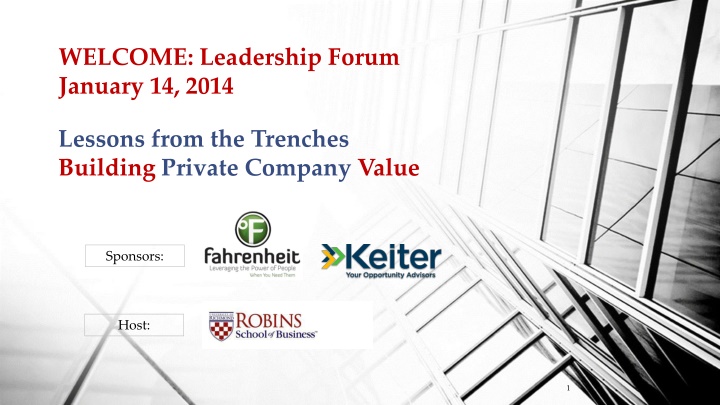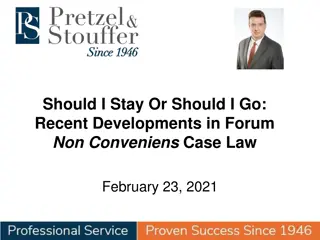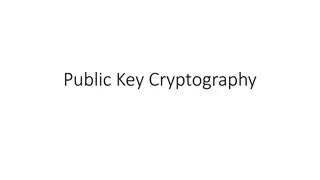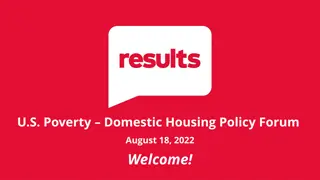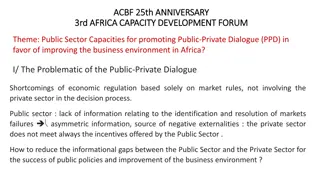Lessons in Building Private Company Value: Key Insights from Leadership Forum
Discover valuable insights on building private company value from the Leadership Forum held on January 14, 2014. Topics covered include legal considerations, business value planning, and key factors in strategic planning for successful business growth.
Download Presentation

Please find below an Image/Link to download the presentation.
The content on the website is provided AS IS for your information and personal use only. It may not be sold, licensed, or shared on other websites without obtaining consent from the author.If you encounter any issues during the download, it is possible that the publisher has removed the file from their server.
You are allowed to download the files provided on this website for personal or commercial use, subject to the condition that they are used lawfully. All files are the property of their respective owners.
The content on the website is provided AS IS for your information and personal use only. It may not be sold, licensed, or shared on other websites without obtaining consent from the author.
E N D
Presentation Transcript
WELCOME: Leadership Forum January 14, 2014 Lessons from the Trenches Building Private Company Value Sponsors: Host: 1
Todays Panelists Dave Bosher Director, Advisory Services, Fahrenheit Advisors dbosher@fahrenheitfinance.com Ben English Partner, Hirschler Fleischer benglish@hf-law.com Tripp Leonard, CFP Partner, Virginia Asset Management, LLC tripp.leonard@vamllc.com Barry Johnson Managing Director, Windward Advisors, LLC bjohnson@ToWindward.com Mike Gracik Managing Partner, Keiter mgracik@KSHGS.com 2
Introduction Transitions put many facets of a company under a spotlight Owners and managers may not be aware of some S.W.O.T. Lessons learned by others can help you and your company Interdisciplinary team approach 3
Key Discussion Topics Legal considerations Building business value Tax and succession planning Owner objectives and capital allocation considerations 4
Key Legal Considerations Use legal agreements as risk management tools Clear and current contract provisions Rights in intellectual property Ownership interests and the securities laws Employment-related agreements Estate planning 5
Building Business Value Plan Your Work and Work Your Plan Fundamentals for Success The most successful companies: know their core competencies have a keen understanding of their markets and their own positioning have clear mission statements and corporate objectives which are communicated throughout the organization which are S.M.A.R.T. (specific, measureable, attainable, relevant & time-bound) continually measure performance to goals and objectives while remaining fluid to adjust as conditions require (SMARTER evaluate, re-evaluate) A Starting Point A corporate self-assessment (Situational Analysis): It is a capital mistake to theorize in advance of the facts Sherlock Holmes- performing a Strengths, Weaknesses, Opportunities and Threats (SWOT) analysis, both at the corporate and business unit level best done with both management and Board participation A SWOT analysis gives rise to: prioritized actionable plans Provides the basis for a formal strategic plan Business Logic (customer, product, economic, structural) Operating Environment (customer, competitor, economic, technological, social, political, legal, and physical) 6 6
Building Business Value Key Considerations in Building a Strategic Plan Establishing a functional advisory board Engaging competent trusted advisors Assessing growth strategies - organic and/or acquisitions Capitalization of the business Building organizational depth Developing scalable and solid business information tools: management, operational and financial reporting establishing key performance metrics Development of detailed metric-driven projections and forecasts with full management participation Continual communication throughout the organization of performance to goals Leveraging the knowledge base of the entire organization and rewarding achievement 7 7
External Value Drivers Availability and access to debt and equity capital Industry condition and trends Growth attributes Stability Cyclicality Fragmentation Consolidation trends Technology Product or service risk Competition Economic environment, investor confidence Political environment (i.e. coal industry) Public market valuations Company performance relative to competitors and economy Strategic buyers appetites for acquisitions 8 8
Internal Value Drivers Solid performance record and operational consistency Meeting plans and projections Consistent pattern of growth Good internal controls and reporting structures which support accountability A well thought-out collaborative strategic and growth plan Identification of new markets where you can win and lead Creating sustained competitive advantage New products and proprietary processes Increased sales channel efficiency in current markets/products A solid management team Leaders that can manage independently Experienced, A players in key positions Focus on proprietary assets, products and revenue streams patents, trademarks, brands, intellectual property, etc. Customer and vendor diversification Effective management of capital to maximize ROI and preserve capital for growth Environmental or legal risks Effective internal governance Efficient legal corporate structure 9 9
Succession Planning - Building/Retaining Business Value Typical Fact Pattern Founder is sole shareholder; one child active in the business and another is interested; two not interested Founder owns real estate and controls all key business relationships Management team is solid but needs new CFO Objectives Create liquidity to fund retirement Create opportunities for children interested in the business, while being fair to those who are not Ensure ongoing viability of the company Minimize taxes Financial Considerations Issues Solutions Does founder have realistic expectations of ability to fund retirement? How to transition control while minimizing taxes? Get a valuation Exempt gifts of stock Redeem founder stock with a combination of senior debt and seller note Is company cash flow sufficient to service the debt? Seller note terms retain significant control for the founder Consulting agreement for founder Key man life insurance on CEO son 10
Succession Planning - Building Business Value Management Considerations Ability of the management team to operate without the founder? Will the heir apparent be up to the task? Will non-family management remain with the company? Issues Solutions Carefully orchestrated transition from founder to successor Training and mentoring for successor Evaluate qualifications and provide training for family members Create incentive for non-family management Strategic planning built around business and family goals Family Considerations Is Founder ready to pass the torch? Does successor really want the job? Should family members not working in the business own stock? Is employment a birthright? How to make it fair for everyone? Issues Solutions Honesty and communication Founder develops a plan for life beyond the business Arm's length evaluation of family members as employees (CEO or otherwise) Bifurcate management and ownership of the business Use other assets to allocate value to children not involved in the business 11
Owner Objectives - An Investor Mindset Owner Objectives: Personal & Corporate are Interconnected Owner s unique objectives drive strategy Be able to articulate answers annually--- to the following: Desired timeframe in current role Owner s required value (versus desired) from the business Desired successors of the business Anticipate Trouble Creative destruction What keeps you up at night? Invest in it. The Institutional Imperative BRK 1989 Shareholder letter For example: 1. As if governed by Newton's First Law of Motion, an institution will resist any change in its current direction; 2. Just as work expands to fill available time, corporate projects or acquisitions will materialize to soak up available funds; 3. Any business craving of the leader, however foolish, will be quickly supported by detailed rate-of- return and strategic studies prepared by his troops; and 4. The behavior of peer companies, whether they are expanding, acquiring, setting executive compensation or whatever, will be mindlessly imitated.
Owner Objectives - An Investor Mindset Think Like an Investor: Capital Allocation Framework Owner-level thinking vs. Operator The reinvestment decision: The What Will They Do With the Cash Factor Reinvestment opportunities offered by the operating company Bolt-on/strategic acquisitions Stock repurchase (less relevant in closely-held corporations) Dividend (distribution or bonus in closely-held corporation) To invest/diversify Or, to consume Understand constraints: Illiquidity Liquidity is defined as an asset's ability to be sold without causing a significant movement in the price and with minimum loss of value; With an illiquid asset, the lack of ready buyers leads to larger discrepancies between the asking price (from the seller) and the bidding price (from a buyer) than would be found in an orderly market with daily trading activity. Risk premium Business valuation multiple Capital allocation flexibility a competitive advantage Diversify your balance sheet
Berkshire Hathaway, Inc. : Holding Company Structure As per 12/31/2012 Operating/Control Non-Operating INSURANCE Liquid/Marketable Securities: Company (in millions) American Express Company The Coca-Cola Company ConocoPhillips 2.0 1,219 1,399 DIRECTV 3.8 1,057 1,154 IBM 6.0 11,680 13,048 Moody s Corporation Munich Re Phillips 66 POSCO 5.1 768 1,295 The Procter & Gamble Sanofi 2.0 2,073 2,438 Tesco plc U.S. Bancorp Wal-Mart Stores, Inc. 1.6 2,837 3,741 Wells Fargo & Company Others Cost* Market 13.7 $ 1,287 8.9 1,299 14,500 $ 8,715 Regulated Cap Intensive 12.7 287 1,430 11.3 2,990 3,599 3.3 660 1,097 1.9 336 3,563 5.2 2,350 2,268 4.2 2,401 2,493 Manufacturing, Service, & Retailing Operations 8.7 10,906 15,592 7,646 11,330 Total Common Stocks at Market $49,796 $87,662 And 65+ Others Cash & Cash Equivalents Fixed Maturity Securities $42,000 $32,000
Capital Allocation Strategy Investor Paradigm: Owner-Based Planning Operating/Control The Reinvestment Decision Non-Operating Commercial/Inv Real Estate Qualified Investments Liquid/Marketable Securities: 401Ks/IRAs/Profit Sharing Commercial Building XXX Capital Operating Account
Internal Value Drivers 1. A solid, motivated management team 2. A realistic growth strategy 3. Effective operating systems and processes 4. A solid, diversified customer base 5. Proprietary products and technology 6. Effective financial controls and processes 7. Consistent, growing financial performance Scoring On These Issues Determines Long-term Value 17 17
Internal Value Drivers A solid, motivated management team Leaders who can take it to the next level Leaders who play well together Leaders who will help you develop a healthy corporate culture 18 18
Internal Value Drivers A realistic growth strategy Key components include, but are not limited to: Developing market strategy to win in current markets creating barriers to entry identification of new markets creating sustained competitive advantage Assessment of quality of business processes new products Developed collaboratively with management team and board Assessment of organizational talent Determination of acquisition opportunities Capital requirements to execute the strategy 19 19
Internal Value Drivers Effective operating systems and processes ability to sustain the growth and scaling of the business integration of operating, ERP and financial systems systematic talent recruitment and training processes documentation of key processes and work flows 20 20
Internal Value Drivers A solid, diversified customer base target markets with solid growth attributes minimal revenue concentration in a few key accounts Demonstrable high retention rates High customer satisfaction scores 21 21
Internal Value Drivers Proprietary products and technology products insulated from competitive encroachment will support premium pricing product development finely tuned to target markets 22 22
Internal Value Drivers Effective financial controls and processes detailed, bottoms-up financial plans and projections strong internal controls accountability driven documentation of key processes disciplined internal governance who approves large expenditures contract approvals pricing controls compensation adjustments Financial reporting tailored to the business Supports tracking of actual to business strategy and tactics Effective use of dashboards and KPI reporting 23 23
Internal Value Drivers Consistent, growing financial performance consistency of results leads to a premium value Intentional, unyielding focus on accountability and performance to promises/plans effective use of capital Working capital management Investment spending tied to strategic plan objectives instill a culture of continual operating improvement 24 24
